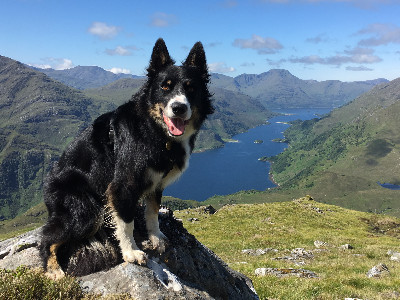
Losing your dog on the hill is a frightening and stressful experience for both the dog and the owner.
No owner ever intends it, but lost dogs do happen, and an increasing number of dogs are finding themselves separated from their owners on the hills. All dog owners who take their pets into the hills have a responsibility to keep them safe and under control and it is essential that owners take the necessary precautions to prevent their dogs from becoming lost in the first place.
You cannot just take a dog into the hills and expect it to be able to walk for miles and know how to behave in unfamiliar and – for the dog – very exciting terrain. Dogs should be introduced gradually to the hills and taught how to behave appropriately. Dogs who are normally calm on walks around their local area can become overexcited when confronted with the open slopes found on the Scottish mountains. Their behaviour can become erratic and they will often chase animals or birds, unaware of the potential danger this may put them in or the damage and stress they may cause to other animals and birds.
Even the most obedient dogs suffer from selective deafness and will ignore voice commands when their attention has been caught by something more exciting.
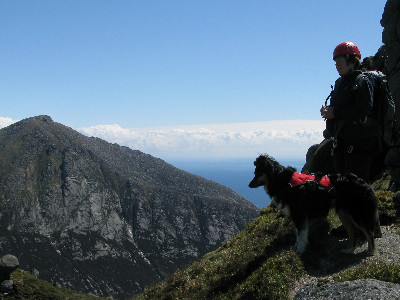
Unless your dog has consistent recall, it should be kept on a lead. Even a trustworthy dog should be kept on a lead around livestock, deer and ground nesting birds. For the dog’s safety a lead is advisable when traversing narrow ridges, near steep drops or cornices.
Dogs should always be kept on a lead during the lambing season.
It is advisable to attach the lead to a harness rather than risk damage to the delicate structures in the dog’s neck where the collar sits. Dog trainers and veterinary physiotherapists recommend a Y-shaped harness which runs down the breastbone and does not put pressure on the soft tissues of the shoulder joint or restrict movement of the shoulder or forelimbs.
Many pet shops provide a fitting service to ensure the harness is suitable for the dog and the activities you wish to undertake.
Ruffwear and Hurtta harness are designed for active dogs and even have handles to help lift the dog if necessary.
Ensure collars and harnesses are snug-fitting (two fingers tightness) as loose collars/harnesses can get snagged and the dog may become trapped.
A bungee lead is ideal. These can be attached around the owner’s waist and the strong bungee absorbs sharp pulls and shocks and also allows the owners to keep their hands free for using poles or to navigate.
Teaching your dog to return to you following a blast on the whistle is an effective recall tool to use on the hill, it is ideal for when the dog is distracted or if a rapid recall is needed.
A whistle has several advantages over vocal recall:
Dogs hear at a higher frequency than humans and are more likely to respond to a whistle than the human voice.
The whistle can also be heard at a much greater distance than the voice, especially in windy conditions or if the dog has roamed any distance away from the owner.
If you are calling the dog and it hasn’t come back you will become stressed and angry – and why would a dog come back to someone who is angry? A whistle will remove any stress or emotion from the recall command.
Recall training to the whistle is easily taught at home, a variety of training programmes are available online or booking a 1:1 lesson with a local dog trainer can be particularly helpful.
Acme Gundog whistles are lightweight and can be worn round your neck or attached to the rucksack.
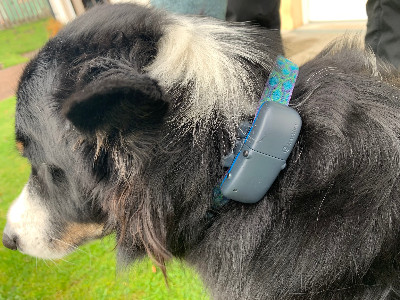
Although they are not infallible, GPS trackers are one of the most reliable ways to locate a dog on the hill.
GPS trackers need a mobile phone signal to connect to the device which is attached to the dog’s collar or harness. However, the tracker unit will still work without a phone reception as it uses a GPS signal to track the dog and there is no maximum range so can locate the dog even if it has roamed a long way from the owner. Some models have a history function so will show where the dog has been plus an active tracking setting to indicate the dog’s current location and some have a light and sound function which can be activated from the phone app.
There is a good range of GPS trackers available and potential buyers should research which model would best suit their needs. Some brands require an ongoing subscription in addition to the purchase price.
In poor visibility anything that will make the owner aware of the dog’s location is helpful. Attaching bells to the dog’s harness or collar will provide an audible clue that the dog is not as close by as it should be and should be recalled back to the owner’s side.
https://www.barkandridesports.com/product/lock-load-slay-bells/
LED lights are ideal for locating the dog in poor visibility or after dark.
A great variety of lights to clip onto the collar or harness or full LED collars are available.
Microchips
Since April 2016 it has been UK law that all dogs are microchipped.
A microchip contains identifying information for the dog and contact details for the owners. If a lost dog is taken to a vet or Police station, they will scan it for microchip details. Ensure your dog’s microchip details are kept up to date at all times.
It is helpful to add another contact number such as a your home or holiday address to the microchip database in case the owner is out of signal on the hill and the dog has been found
Collar and ID tag
An ID tag should be attached to the dog’s harness or collar with the owner’s mobile phone number. It is possible to add a second or third number to the ID tag for a relative or friend.
A lost dog will often attach itself to other walkers on the hill, and a simple collar and tag with phone numbers attached will allow contact with the owners.
Collars with mobile phone numbers embroidered into them are also available.
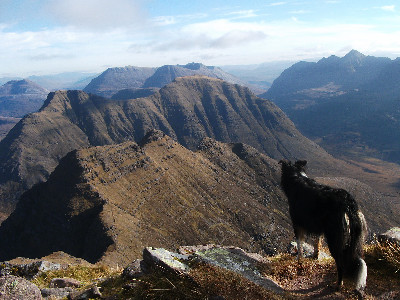
Dogs do go missing. They may chase wildlife or livestock, they may disappear in poor visibility or follow other people or dogs. It is important to know what to do if your dog goes missing.
As soon as your dog goes missing make sure you turn your phone on (or take it out of airplane mode) so people can contact you if have found your dog.
Open the GPS/compass or OS Locate app on your phone, Google maps or your GPS device and make a note of the grid reference where the dog was last seen. The OS Locate app is a free app which will give an OS grid reference and has an inbuilt compass.
Open the Endomondo app on your phone to track and record your search area. The Endomondo app is a free tracker that can be downloaded on a smartphone and will track your steps as you search.
The dog will often come back to the last place that it was with you so it is worth staying put for a little while rather than charging off around the hillside.
If your dog doesn’t return retrace your steps back over the same route, as dogs rely on scent and sound to find their owner. If you change course the dog may become confused about which way the scent trail is going and they do not look for footprints like humans do.
There's an old dog handler's trick that is probably worth trying if you've lost contact withyour dog while on the hill.
Derry Argue, author of 'Pointers and Setters' and who has trained and worked with dogs all his life, says: "One tip I learned when I was training pointers and setters and had lost one on the hill, was to put an old coat on a post near where I parked the car. When the dog has realised that it is lost, it will often (but not always) back track to where it got out of the car. But by that time, the owner has often driven off, so the trail ends. Then I realised, if I left my coat, went home and had my tea, I'd often find the dog curled up asleep when I returned later. This is a simple trick that can work and it costs very little to try."
Perhaps worth a try.
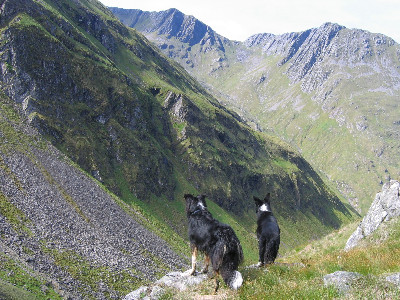
Mountain Rescue Teams are authorised by the Police to search for or rescue people injured or at risk in the mountains. But they are not routinely deployed by the Police to assist in the search for lost dogs as this would mean that teams would not be available if people need rescuing elsewhere.
However If you find a dog who is trapped or injured, call 999 and ask for Mountain Rescue. Do not place yourself or others in danger trying to rescue a trapped dog yourself. If the dog is injured the Mountain Rescue Team Leader will decide whether they are able to launch a call-out based on the information they have received from the owner.
If organising an informal search party, it is vitally important to consider the terrain, location and weather - and the experience and equipment of the people involved in the search. Many willing volunteers are not regular hillwalkers and may be putting themselves and rescuers in danger if they get into difficulty during the search.
Stay calm and try not to panic. Search methodically and call your dog’s name and blow your whistle. Allow quiet spells and listen carefully as the dog may be trapped and making noises or barking.
Contact a friend or relative and ask them to contact local vets, Police, council dog wardens and shelters and place notices on hillwalking Facebook pages with a photo of your dog, contact numbers and the location the dog went missing.
If the dog is missing near farmland it is worth trying to contact local farmers or gamekeepers who are often willing to help search and have a detailed local knowledge of the area.
Drone SAR for Lost Dogs UK is an organisation of drone pilots who will assist with searches for dogs in remote or mountainous areas. It is advisable to contact them ASAP.
Dog Lost is an organisation which offers support and advice for owners of missing dogs.